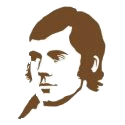
|
|
Perth Burns Club |
|
| | home | about | committee | presidents | constitution | syllabus | membership | | |
| | annual dinners | st andrew's days | schools festivals | summer outings | | |
| | immortal memories | book library | video gallery | burns in perth | links | contact | |
St Andrew's Day
A day of Scottish life and culture
| 2025 | 2024 | 2023 | 2022 | 2021 | 2019 | 2018 | 2017 | 2016 | 2015 | 2014 | 2013 | 2012 | 2011 | 2010 | 2009 | 2008 |
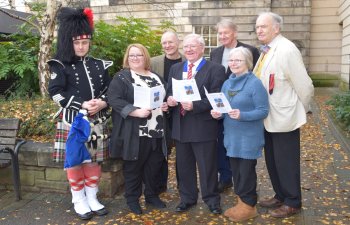
Presenters, officials and piper gather beforehand. Left to right: Martin Bristow [piper], Helen Smout [CPK CEO], James Robertson, Stewart MacDougall [president], Jim Crumley, Joan Allan [vice-president], Professor David Purdie.
Perth's main celebration of St Andrew's Day, the fifteenth Perth Burns Club's annual Day of Scottish Life and Culture, was held in the Soutar Theatre at the A. K. Bell Library, York Place, Perth on Saturday, December 1st, 2018.
Yet again the event maintained its reputation for high quality, and an attentive audience of 50 were treated to a thoroughly enjoyable, diverse, and insightful programme. All the presenters were in excellent form, with their contrasting styles plus some unscripted interplay adding to the congenial nature of the afternoon.
Principal Speakers
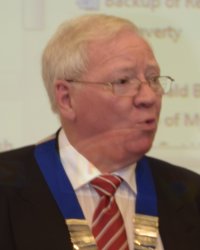
Stewart MacDougall
After being piped in by Martin Bristow, the audience was welcomed by club president and chairman for the day, Stewart MacDougall, who intimated good wishes from the Vancouver Burns Club president Donald Paton, then invited CPK CEO Helen Smout to give the opening address.
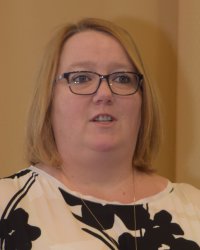
Helen Smout
Helen expressed her thanks to Perth Burns Club for organising the day, and for being an integral part of Perth's St Andrew's Day celebrations.
Helen's own organisation CPK (Culture Perth & Kinross) is not yet 3 years old, and she ran a video showing the range of activities and events under the CPK banner.
A central CPK theme is words and stories, with the William Soutar Writing Prize being reintroduced this year and the Festival of Words taking place in April 2019 - Soutar again features in a very eclectic programme, which includes Scots and Gaelic content.
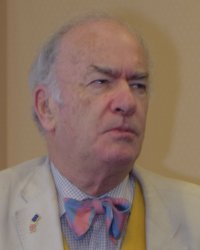
Professor David Purdie
Our first speaker was Professor David Purdie who presented "Three Stars of the Enlightenment: David Hume, Robert Burns and Walter Scott". David is an Honorary member of our Club and a most distinguished speaker in both academic and after-dinner circles. He didn't disappoint; a magisterial performance, full of erudition, anecdote and instructive illustration.
David first recounted the parallel developments in Athens and Florence, all based on an upsurge of evidence-based thought, rather than the established Church doctrines where faith often predominated over reason. Socrates lost his life by challenging the orthodoxy, but gradually humanist and rationalist outlooks prevailed.
In 18th and 19th century Scotland, the Church assisted via the network of parish schools, and this, plus a greater emphasis on university education meant literacy was more widespread here than south of the border.
David Hume, the philosopher, historian, economist, and essayist, whose Treatise on Human Nature (1738) and Essays, Moral and Political (1741) helped outline the parameters of philosophical Empiricism and Scepticism, was an early torch-bearer.
Burns' contribution to the times followed from the work of Robert Fergusson (1750�74), and featured his own poems and song-collecting. His work demonstrated knowledge of Classical, Biblical, and English literature, as well as the Scottish Makar tradition.
Walter Scott combined his legal career with literary works, including The Minstrelsy of the Scottish Border; poetry (e.g. The Lady of the Lake); and his famous historical novels beginning with Waverley and including Old Mortality and The Fair Maid of Perth.
David illustrated Hardie's famous portrait where Burns met the 15 year-old Scott in Edinburgh, in the company of Adam Ferguson, Adam Smith, James Hutton and other luminaries of the Enlightement.
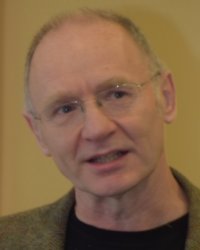
James Robertson
James Robertson was next up to recall the life of �Michael Marra�, his former neighbour in Newtyle, Angus. James had published a biography of Michael entitled Arrest This Moment in 2017. Many of his slides came from that source, illustrating Michael's upbringing and career, and showcasing his great artistic as well as musical talents.
James provided genuine insights into the personality and thinking of Michael, often gained from the Kitchen Conversations they enjoyed together. Michael was an independent spirit; a rebel at school, but a talented lad whose humanity and humour overcame life's knockbacks. Michael was unable to read or notate music, but avidly taught himself to create and compose. His early promise resulted in a recording contract with Polydor in London, but he couldn't live happily with their antipathy towards his language and culture. He returned home, convinced that doing it his own way was worth more than commercial success.
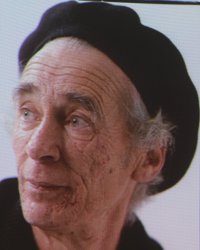
Michael Marra
James provided great sound clips of Michael's work, featuring some of his influences (e.g. Randy Newman, Abdullah Ibrahim) and his own works including Hermless and Chain Up The Swings. Also illustrated were Michael's acting career (e.g. The Mill Lavvies) and collaborations (e.g. In Flagrant Delicht) with Liz Lochhead.
This was a really sensitive portrait of a genuine and honest artist whose humorous observations of life have left us with a rich legacy. There is much in the cupboard that remains unexplored, and James mentioned a PhD might be in the making for an enthusiastic researcher.
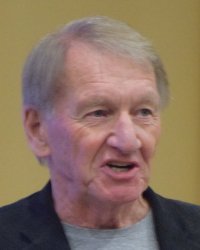
Jim Crumley
The final presentation of the afternoon was given by Jim Crumley, who is well-known for his nature articles in the Courier and Scots Magazine. Jim had spent the last 5 years researching a tetralogy of works covering the seasons. Autumn and Winter are now published; Spring is at the printers and, as the song says, it won't be long till Summer's here.
Jim had to adapt his field research to tackle the project. His normal habitat is relatively short time spans, with concentration on a single (or very few) species. Here, variations over months and years had to be amassed, and a wider range of place, climate, flora and fauna included to match the brief. The results are impressive, and his presentation of them in prose and verse had an enchanting lyrical quality. Two examples of many:
From The Nature of Autumn: The Ploughman's Apology. Burns' famous To a Mouse is examined to understand the significance of the second verse, written in English. Jim postulates that Burns was trying to reach a wider audience with an apology to the mouse (and to all of nature) on behalf of humankind for screwing up the planet. Jim also quotes Burns' rage against the shooters who killed a hare, and recommends that we read On Scaring Some Water-Fowl in Loch Turit (near Ochtertyre).
From The Nature of Winter: I Went Out to the Hazel Wood. In this passage, Jim recounts his visit to a hazel wood on the west coast of Mull. The hazel can self-coppice and provides a source of straight poles and winter nuts; but it also provides habitat for brambles, brown hares, swallows and martins. The Mull hazel is somewhere between a tree and a shrub; it looks neat and coralled, but inside it seethes. Beside the ocean, it just works.
Jim's Q&A session was lively and his ability to answer prickly questions on the reintroduction of species was very impressive. No tub-thumping, but a convincing message that we have to listen to nature rather than think we can control it.
Club vice-president Joan Allan brought a great afternoon to a close with a lovely vote of thanks for the efforts of the organisers, the excellent performances of all the presenters, and the very supportive and participative audience.
All photographs courtesy of
Elliott Boyle, Perth Burns Club.
Email Elliott if you'd like a copy of a photograph.